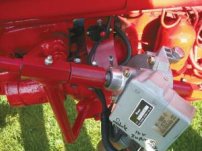welderboyjk
Cast Iron
- Joined
- Nov 22, 2006
- Location
- south west michigan
Type 2 pumps are also called TC or transverse compact. Think they were mostly meant for transverse mounted engines. Nearly all are "standard" rotation I.E. clockwise when viewed from the pulley side. There were a couple of limited varieties that were reverse rotation but they're few, far between and more spendy than the standards.
They are/were available stock in either plastic clip on reservoir design or with an installed tube for a remote reservoir hose. Never saw one with a two port return reservoir but they may be out there.
If you're handy make your own.
Orifice fitting (outlet) fittings are typically 90° counterclockwise from the feed port when viewed from the shaft end. They are available 90 clockwise but in fewer applications.
Housings were made of either aluminum or steel.
The rotating group was offered with 3 different cam rings. A 40 series, 60 series or an 88 series. The 88 having the largest eccentric or highest flow capabilities.
Any of the mounting bosses can be drilled out for through bolt mounting. The face mount or rear mount threaded bosses are plenty big enough to open up to allow a 5/16" bolt.
As originally designed with stock parts you can get a little higher pressure from the aluminum housed variety. About 1450 or 1500 pounds is all you'll want to push them to if you ever test one on a stand and listen to it run at pressure.
If you are going to pair it with a hydroboost find the specs for your hydro unit and match the pump flow and pressure specs to it. You'll avoid many headaches.
They are/were available stock in either plastic clip on reservoir design or with an installed tube for a remote reservoir hose. Never saw one with a two port return reservoir but they may be out there.
If you're handy make your own.
Orifice fitting (outlet) fittings are typically 90° counterclockwise from the feed port when viewed from the shaft end. They are available 90 clockwise but in fewer applications.
Housings were made of either aluminum or steel.
The rotating group was offered with 3 different cam rings. A 40 series, 60 series or an 88 series. The 88 having the largest eccentric or highest flow capabilities.
Any of the mounting bosses can be drilled out for through bolt mounting. The face mount or rear mount threaded bosses are plenty big enough to open up to allow a 5/16" bolt.
As originally designed with stock parts you can get a little higher pressure from the aluminum housed variety. About 1450 or 1500 pounds is all you'll want to push them to if you ever test one on a stand and listen to it run at pressure.
If you are going to pair it with a hydroboost find the specs for your hydro unit and match the pump flow and pressure specs to it. You'll avoid many headaches.





